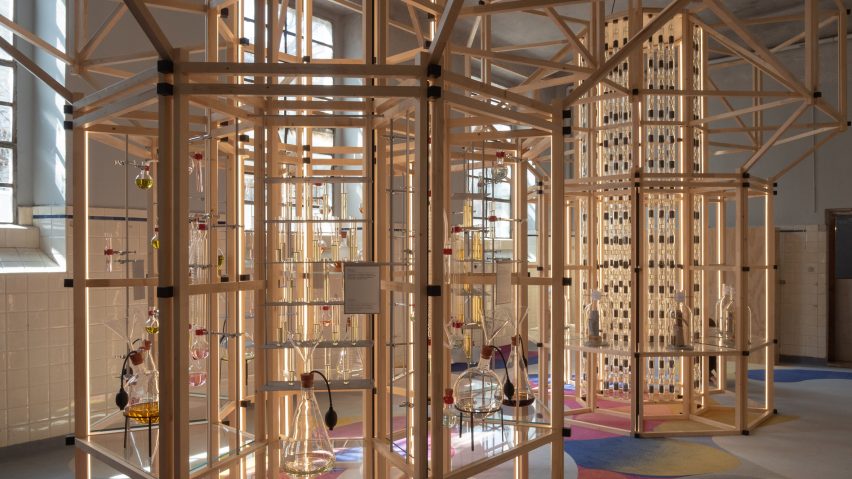Following this year's Milan design week, Dezeen has highlighted ten standout exhibitions, installations and shows at the Milanese festival, ranging from textiles made from brick to a denim-clad jet plane.
Milan design week is the biggest annual design event in the world and encompasses a number of exhibitions, shows and installations across the city of Milan, as well as hosting Salone del Mobile – the world's largest and most important furniture fair.
Among the trends at this year's Milan design week were installations by large fashion houses, industrial waste materials being used to reduce the environmental impact of new products and meetings between digital and physical designs.
Below, the Dezeen team has selected ten key shows and installations that it visited during the week-long event:
Brick Textiles by Natural Material Studio
Presented at Alcova, a travelling exhibition showcase for independent design, Natural Material Studio and Polish designer and researcher Zuzanna Skurka created textiles from porous repurposed bricks that were sourced from demolition projects.
"We were very curious about this question of how can architecture be flexible, more simple and translucent even? It's all the opposite aspects of a brick," said Natural Material Studio founder Bonnie Hvillum.
"When we think of brick it's like a solid, rigid, structural wall," she continued. "But how can we make more flexible and fluid architecture today?"
Find out more about Brick Textiles ›
Designer Robert Stadler showcased a series of whimsical furniture and lighting pieces in the shape of fruit and vegetables at the Carwan Gallery.
Named OMG-GMO, the collection features straight carrots, square watermelon slices and spotless bananas intending to be a humorous comment on how the natural appearance of food has been altered.
Poikilos by Objects of Common Interest
This show at Nilufar Depot featured 13 iridescent objects created by New York- and Athens-based studio Objects of Common Interest using a secret resin recipe.
Romanian-born craftsman Ovidiu Colea taught Objects of Common Interest founders Eleni Petaloti and Leonidas Trampoukis the formula so they could continue his legacy.
The exhibition showed the results of their first experiments, including the three-legged Klisis chair, the concave Afairesi console and the whale-like Stala coffee table.
Find out more about Poikilos ›
More or Less by Maarten Baas and G-Star RAW
Dutch designer Maarten Baas collaborated with denim brand G-Star RAW to create the exhibition More or Less, which was shown inside the Milanese church San Paolo Converso.
Baas constructed a life-size private plane that was wrapped in a skin constructed from panels of recycled denim. According to Baas, the installation was a comment on issues of sustainability.
A triptych of jean-shaped cabinetry, similarly constructed from denim, was presented alongside the jet.
Find out more about More or Less ›
A cube wrapped in ribbons of reflective ETFE – a plastic polymer – by architecture studio MAD was anchored at a 45-degree angle to the grassy lawn of the University of Milan as part of the Interni Design Re-Evolution exhibition.
Called Momentum, the installation was created in collaboration with lighting company L&L Luce&Light, which supplied a series of lights that were placed within the interior of the cube to create a glowing illumination at night.
Find out more about Momentum ›
Shaped by Water by Lachlan Turczan and Google
Reflective stainless-steel basins filled with water act as giant speakers in this installation by American artist Lachlan Turczan, helping to visualise different sounds and even an entire 10-minute music piece through the ripples created in the water.
Sponsored by Google, the exhibition was designed to illustrate the hidden qualities of water and how they have influenced the tech giant's hardware design.
Find out more about Shaped by Water ›
Clay Court Club by Cristina Celestino
Italian architect and designer Cristina Celestino temporarily took over the headquarters of the Tennis Club Milano Bonacossa, a building designed by renowned Milanese architect Giovanni Muzio and constructed in 1930.
Her installation saw the building updated with furniture and fittings that featured playful references to tennis. These included chairs with interwoven details akin to traditional tennis rackets and a bench that took cues from courtside seating.
Find out more about Clay Court Club ›
Harmony of Form and Function by Shigeru Ban
Japanese architect Shigeru Ban referenced his long-standing interest in biomaterials when designing the installation space for The Harmony of Form and Function exhibition, which showcased architect Frank Lloyd Wright's Taliesin lights.
The lamps were displayed in a tactile arched tunnel made from paper tubes, illuminated only by a window that featured one of Wright's own leaded-glass designs.
Find out more about Harmony of Form and Function ›
Expériences Immobiles by DWA Design Studio and Les Eaux Primordiales
As part of the Alcova showcase, Italian interiors practice DWA Design Studio designed an olfactory installation for perfume brand Les Eaux Primordiales, including smellable ceramics dipped in its latest scent.
The installation itself takes the form of two octagonal towers, designed to resemble factory chimneys and constructed from a demountable timber-frame system.
Find out more about Expériences Immobiles ›
3D-printed prosthetic limbs for Ukraine from Ro Plastic Prize by Isinnova
Named the winner in the category for Emerging High Technology at the 2023 Ro Plastic Prize, Italian company Isinnova designed an artificial leg that can be produced quickly and at a low cost for emergency situations.
The prosthetic leg was first developed in response to the war in Ukraine and is made mostly from recycled plastic, which was 3D-printed into custom designs.
Find out more about 3D-printed prosthetic limbs for Ukraine ›
Milan design week took place during 17-23 April. For more events, talks and installations in architecture and design visit Dezeen's Events Guide.

